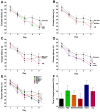Large-Scale Oral Treatment Study with the Four Most Promising D3-Derivatives for the Treatment of Alzheimer's Disease
- PMID: 28994710
- PMCID: PMC6151452
- DOI: 10.3390/molecules22101693
Large-Scale Oral Treatment Study with the Four Most Promising D3-Derivatives for the Treatment of Alzheimer's Disease
Abstract
Alzheimer's disease (AD) is a progressive neurodegenerative disorder that is associated with the aggregation of the amyloid β protein (Aβ). Aβ oligomers are currently thought to be the major neurotoxic agent responsible for disease development and progression. Thus, their elimination is highly desirable for therapy development. Our therapeutic approach aims at specific and direct elimination of toxic Aβ oligomers by stabilizing Aβ monomers in an aggregation-incompetent conformation. We have proven that our lead compound "D3", an all d-enantiomeric-peptide, specifically eliminates Aβ oligomers in vitro. In vivo, D3 enhances cognition and reduces plaque load in several transgenic AD mouse models. Here, we performed a large-scale oral proof of concept efficacy study, in which we directly compared four of the most promising D3-derivatives in transgenic mice expressing human amyloid precursor protein with Swedish and London mutations (APPSL), transgenic mice, to identify the most effective compound. RD2 and D3D3, both derived from D3 by rational design, were discovered to be the most effective derivatives in improving cognition in the Morris water maze. The performance of RD2- and D3D3-treated mice within the Morris water maze was significantly better than placebo-treated mice and, importantly, nearly as good as those of non-transgenic littermates, suggesting a complete reversal of the cognitive deficit of APPSL mice.
Keywords: ">d-enantiomeric peptides; Alzheimer’s disease; Aβ oligomers; amyloid β; cognition; large-scale; oral treatment; transgenic mice.
Conflict of interest statement
The authors declare no conflict of interest.
Figures



Similar articles
-
Increase of Positive Net Charge and Conformational Rigidity Enhances the Efficacy of d-Enantiomeric Peptides Designed to Eliminate Cytotoxic Aβ Species.ACS Chem Neurosci. 2016 Aug 17;7(8):1088-96. doi: 10.1021/acschemneuro.6b00047. Epub 2016 Jun 9. ACS Chem Neurosci. 2016. PMID: 27240424
-
Optimization of d-Peptides for Aβ Monomer Binding Specificity Enhances Their Potential to Eliminate Toxic Aβ Oligomers.ACS Chem Neurosci. 2017 Sep 20;8(9):1889-1900. doi: 10.1021/acschemneuro.7b00045. Epub 2017 Jun 23. ACS Chem Neurosci. 2017. PMID: 28581708
-
Deceleration of the neurodegenerative phenotype in pyroglutamate-Aβ accumulating transgenic mice by oral treatment with the Aβ oligomer eliminating compound RD2.Neurobiol Dis. 2019 Apr;124:36-45. doi: 10.1016/j.nbd.2018.10.021. Epub 2018 Nov 2. Neurobiol Dis. 2019. PMID: 30391539
-
Non-canonical soluble amyloid-beta aggregates and plaque buffering: controversies and future directions for target discovery in Alzheimer's disease.Alzheimers Res Ther. 2017 Aug 17;9(1):62. doi: 10.1186/s13195-017-0293-3. Alzheimers Res Ther. 2017. PMID: 28818091 Free PMC article. Review.
-
Potential therapeutic implications of gelsolin in Alzheimer's disease.J Alzheimers Dis. 2015;44(1):13-25. doi: 10.3233/JAD-141548. J Alzheimers Dis. 2015. PMID: 25208622 Review.
Cited by
-
Peptides as Pharmacological Carriers to the Brain: Promises, Shortcomings and Challenges.Mol Pharm. 2022 Nov 7;19(11):3700-3729. doi: 10.1021/acs.molpharmaceut.2c00523. Epub 2022 Sep 29. Mol Pharm. 2022. PMID: 36174227 Free PMC article. Review.
-
Oral treatment with the all-d-peptide RD2 enhances cognition in aged beagle dogs - A model of sporadic Alzheimer's disease.Heliyon. 2023 Jul 29;9(8):e18443. doi: 10.1016/j.heliyon.2023.e18443. eCollection 2023 Aug. Heliyon. 2023. PMID: 37609390 Free PMC article.
-
Do We Need Anti-Prion Compounds to Treat Alzheimer's Disease?Molecules. 2019 Jun 15;24(12):2237. doi: 10.3390/molecules24122237. Molecules. 2019. PMID: 31208037 Free PMC article. Review.
-
Oral Treatment with RD2RD2 Impedes Development of Motoric Phenotype and Delays Symptom Onset in SOD1G93A Transgenic Mice.Int J Mol Sci. 2021 Jun 30;22(13):7066. doi: 10.3390/ijms22137066. Int J Mol Sci. 2021. PMID: 34209129 Free PMC article.
-
Aβ Oligomer Elimination Restores Cognition in Transgenic Alzheimer's Mice with Full-blown Pathology.Mol Neurobiol. 2019 Mar;56(3):2211-2223. doi: 10.1007/s12035-018-1209-3. Epub 2018 Jul 12. Mol Neurobiol. 2019. PMID: 30003517 Free PMC article.
References
MeSH terms
Substances
LinkOut - more resources
Full Text Sources
Other Literature Sources
Medical

